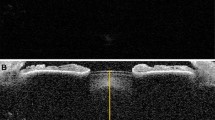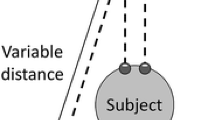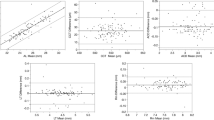Abstract
Purpose
The purpose of the study was to assess non-invasively the changes in the anterior chamber eye, crystalline lens morphology, and ciliary muscle during accommodation by means of an anterior chamber optical coherence tomographer (OCT), and correlate them with vergence.
Methods
Twenty-five eyes of twenty-five healthy subjects, whose mean age was 29.9±7.1 years, were included and measured with an anterior chamber OCT. The central corneal thickness (CCT), anterior chamber depth (ACD), anterior crystalline lens radius of curvature (ALRC), crystalline lens thickness (CLT), and ciliary muscle area (CMA) were measured for each participant at 0, –1, –2, and –3 D of target vergence. A linear model was used to assess the correlation of each eye parameter with the vergence demand.
Results
The mean CCT showed no change for all the accommodative stimuli. The mean ACD and ALRC decreased with the vergence, about 4.5 and 30 % at –3 D, respectively. On the contrary, the CLT and CMA showed an opposite tendency, where the mean CLT was increased by 4.0 % and the mean CMA was done by 26% at –3 D. Statistical significant differences (p < 0.001) were obtained among all vergences for each eye metric, except for the CCT (p = 0.76).
Conclusion
The ACD and ALRC decreased about 2 and 10 % per dioptre of accommodation, respectively; whereas the CLT and CMA increased about 2 and 9 %, respectively. These results add knowledge regarding the understanding of accommodation and give new perspectives for biomechanics and biometry.






Similar content being viewed by others
References
Du C, Shen M, Li M, Zhu D, Wang M, Wang J (2012) Anterior Segment Biometry during Accommodation Imaged with Ultralong Scan Depth Optical Coherence Tomography. Ophthalmology 119:2479–2485
Domínguez-Vicent A, Monsálvez-Romín D, Del Águila-Carrasco A, Ferrer-Blasco T, Montés-Micó R (2014) Changes in the anterior chamber during accommodation assessed with a Scheimpflug system. J Cataract Refract Surg 40:1790–1797
Dexi Z, Shao Y, Peng Y, Chen Q, Wang J, Lu F, Shen M (2016) Real-Time Measurement of Dynamic Changes of Anterior Segment Biometry and Wavefront Aberrations During Accommodation. Eye Contact Lens 42:322–327
Richdale K, Bullimore M, Sinnott L, Zadnik K (2016) The effect of age, accommodation, and refractive error on the adult human eye. Optom Vis Sci 93:3–11
Ruggeri M, de Freitas C, Williams S, Hernandez V, Cabot F, Yesilirmark N, Alawa K, Chang Y, Yoo S, Gregori G, Parel J, Manns F (2016) Quantification of the ciliary muscle and crystalline lens interaction during accommodation with synchronous OCT imaging. Biomed Opt Express 17:1351–1364
Yasuda A, Yamaguchi T (2005) Steepening of corneal curvature with contraction of the ciliary muscle. J Cataract Refract Surg 31:1177–1181
He J, Gwiazda J, Thorn F, Held R, Huang W (2003) Change in corneal shape and corneal wave-front aberrations with accommodation. J Vis 3:456–463
Ni Y, Liu X, Lin Y, Guo X, Wang X, Liu Y (2013) Evaluation of corneal changes with accommodation in young and presbyopic populations using Pentacam high resolution Scheimpflug system. Clin Exp Ophthalmol 41:244–250
Sisó-Fuertes I, Domínguez-Vicent A, Del Águila-Carrasco A, Ferrer-Blasco T, Montés-Micó R (2015) Corneal changes with accommodation using dual Scheimpflug photography. J Cataract Refract Surg 41:981–989
Lee H, Kang D, Ha B, Choi M, Kim E, Seo K, Kim T (2015) Effect of Accommodation on Vaulting and Movement of Posterior Chamber Phakic Lenses in Eyes With Implantable Collamer Lenses. Am J Ophthalmology 160:710–716
McAlinden C, Khadka J, Pesudovs K (2011) Statistical methods for conducting agreement (comparison of clinical tests) and precision (repeatability or reproducibility) studies in optometry and ophthalmology. Ophthal Physiol Opt 31:330–338
Montés-Micó R, Alió J, Muñoz G, Charman W (2004) Temporal changes in optical quality of air-tear film interface at anterior cornea after blink. Invest Ophthalmol Vis Sci 45:1752–1757
Tan W (1982) Sampling distributions and robustness of t, F and variance-ratio in two samples and ANOVA models with respect to departure from normality. Communication in statistics: Theory and Methods 11:486–511
Box G (1965) Some theorems on quadratic forms applied in the study of analysis of variance problems. II: Effects of inequality of variance and of correlation between errors in the two-way classification. Annals of Mathematical Statistics 25:484–498
Mendenhall W, Beaver R, Beaver B (2013) Linear regression and correlation. In: Julet M (ed) Introduction to probability and statistics. Cengage Learning, Boston
Yasuda A, Yamaguchi T, Ohkoshi K (2003) Changes in corneal curvature in accommodation. J Cataract Refract Surg 29:1297–1301
Buehren T, Collins M, Loughridge J, Carney L, Iskander D (2003) Corneal topography and accommodation. Cornea 22:311–316
Read S, Buehren T, Collins M (2007) Influence of accommodation on the anterior and posterior cornea. J Cataract Refract Surg 33:1877–1885
Bayramlar H, Sadigov F, Yildirim A (2013) Effect of accommodation on corneal topography. Cornea 32:1251–1254
Dubbelman M, van der Heijde G, Weeber H (2005) Change in shape of the aging human crystalline lens with accommodation. Vision Res 45:117–132
Kohnen T, Shajari M (2016) Phakic intraocular lenses. Ophthalmologe 113:529–538
Sun Y, Fan S, Zheng H, Dai C, Ren Q, Zhou C (2014) Noninvasive Imaging and Measurement of Accommodation Using Dual-Channel SD-OCT. Curr Eye Res 39:611–619
Ramasubramanian V, Glasser A (2015) Objective measurement of accommodative biometric changes using ultrasound biomicroscopy. J Cataract Refract Surg 41:511–526
Neri A, Ruggeri M, Protti A, Leaci R, Gandolfi S, Macaluso C (2015) Dynamic imaging of accommodation by swept-source anterior segment optical coherence tomography. J Cataract Refract Surg 41:501–510
Shao Y, Tao A, Jiang H, Mao X, Zhong J, Shen M, Lu F, Xu Z, Karp C, Wang J (2015) Age-Related Changes in the Anterior Segment Biometry During Accommodation. Invest Ophthalmol Vis Sci 56:3522–3530
Laughton D, Coldrick B, Sheppard A, Davies L (2015) A program to analyse optical coherence tomography images of the ciliary muscle. Cont Lens Anterior Eye 38:402–408
Bailey M (2011) How should we measure the ciliary muscle? Invest Ophthalmol Vis Sci 52:1817–1818
Author information
Authors and Affiliations
Corresponding author
Ethics declarations
Funding
Authors acknowledge financial support from the Ministerio de Economía y Competitivad (Research Project SAF2013-44510-R with ERDF Funds from the European Union), a University of Valencia research scholarship (UV-INV-PREDOC13-110412) awarded to Alberto Domínguez-Vicent, a University of Valencia research scholarship (UV-INV-PREDOC14-179135) awarded to Antonio J. Del Águila-Carrasco, and a Ministerio de Educación, Cultura y Deporte research scholarship (FPU13/05332) awarded to Daniel Monsálvez-Romín. These sponsors had no role in the design or conduct of this research.
Conflict of interest
All authors certify that they have no affiliations with or involvement in any organization or entity with any financial interest or non-financial interest in the subject matter or materials discussed in this manuscript.
Ethical approval
All procedures performed in studies involving human participants were in accordance with the ethical standards of the institutional and/or national research committee and with the 1964 Helsinki Declaration and its later amendments or comparable ethical standards.
Informed consent
Informed consent was obtained from all individual participants included in the study.
Rights and permissions
About this article
Cite this article
Esteve-Taboada, J.J., Domínguez-Vicent, A., Monsálvez-Romín, D. et al. Non-invasive measurements of the dynamic changes in the ciliary muscle, crystalline lens morphology, and anterior chamber during accommodation with a high-resolution OCT. Graefes Arch Clin Exp Ophthalmol 255, 1385–1394 (2017). https://doi.org/10.1007/s00417-017-3663-4
Received:
Revised:
Accepted:
Published:
Issue Date:
DOI: https://doi.org/10.1007/s00417-017-3663-4




